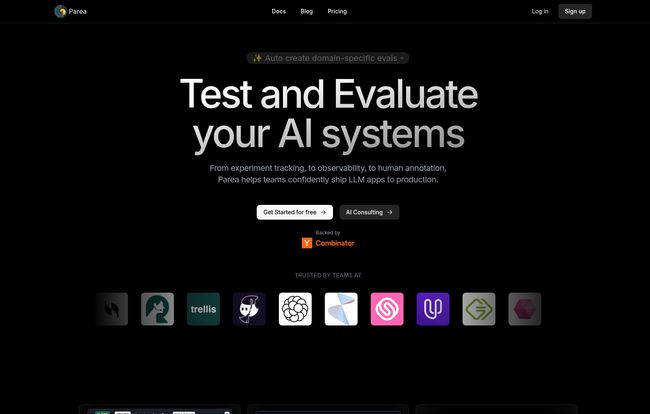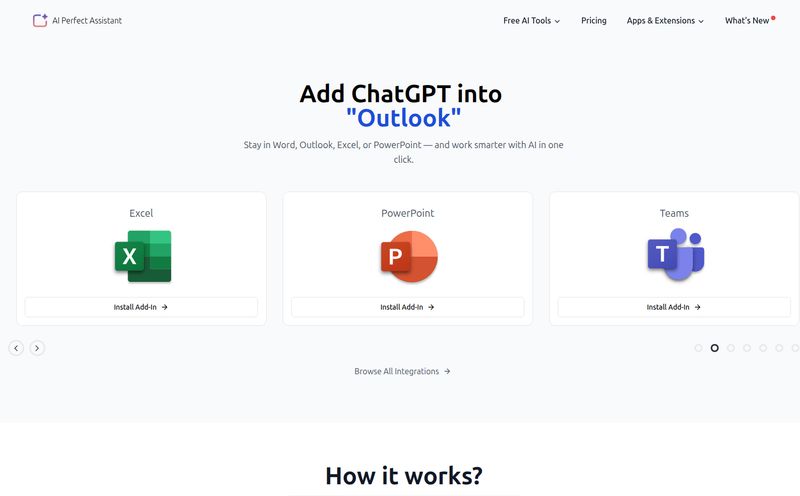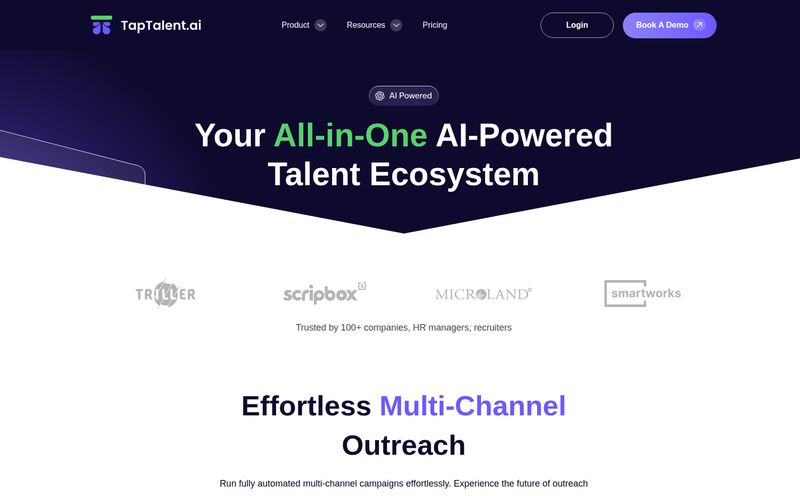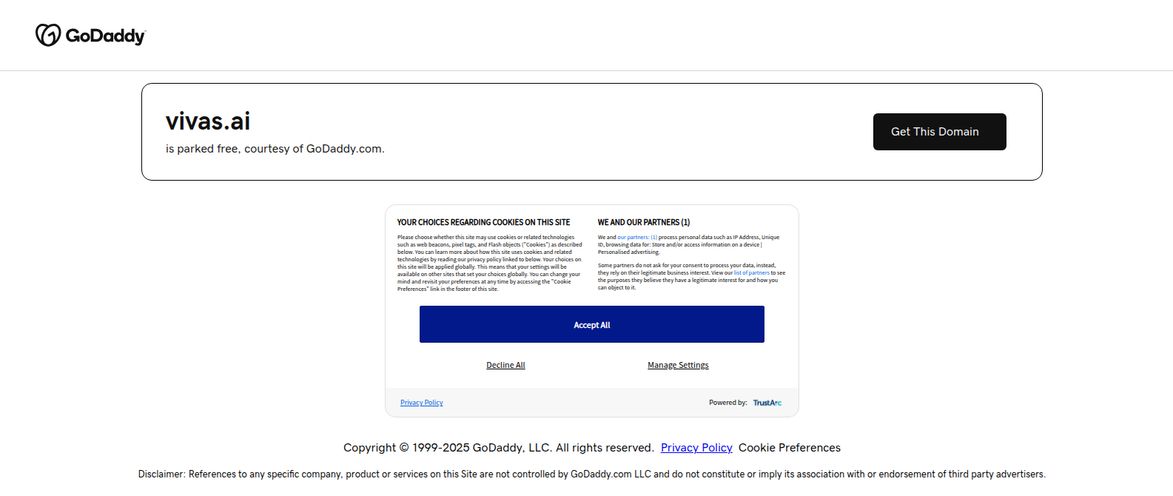Building with Large Language Models feels a bit like the Wild West, doesn't it? One minute you've got a prompt that sings, delivering perfect output. The next, you change one tiny thing, and it starts spouting nonsense. We've all been there, stuck in that loop of 'prompt-and-pray', tweaking a word here, a phrase there, and hoping for the best. It's chaotic, it's inefficient, and frankly, it's not a sustainable way to build production-ready applications.
For a while, I've been on the lookout for a tool that brings some much-needed sanity to this process. Something that goes beyond a simple playground and helps with the entire lifecycle of an LLM app. And I think I might have found a serious contender in Parea AI.
I’ve spent some time kicking the tires on this platform, and I’m ready to share my thoughts. This isn't just another spec sheet breakdown; it's a real-world look from someone who lives and breathes this stuff.

Visit Parea AI
So, What is Parea AI, Anyway?
Imagine a central command center for your AI development. That's the simplest way I can put it. Parea AI is an experimentation and evaluation platform designed specifically for teams building with LLMs. It’s not just about writing prompts. It's about testing them, tracking their performance, seeing where they fail, getting human feedback, and doing it all over again, but smarter this time.
Think of it as the missing instrumentation for your AI stack. It shines a bright light into the black box of LLM behavior, helping you move from 'I think this is better' to 'I can prove this is better with data'.
The Core Features That Actually Get Used
A platform can have a million features, but only a few truly matter in the day-to-day grind. Parea does a good job of focusing on the stuff that moves the needle. Here's the breakdown.
A Playground for Prompts (With a Purpose)
Yes, it has a prompt playground. But it's more than just a text box. This is where you can systematically tinker with your prompts and test them against entire datasets, not just one-off examples. This is huge. You can see how a change affects hundreds of cases at once, which immediately tells you if you're making progress or just fixing one problem while creating three more. When you find a prompt that consistently performs well, you can deploy it right from the platform. That's a slick workflow.
Stop Guessing with Robust Evaluation & Observability
This, for me, is the heart of Parea. Once your app is live, you're flying blind without proper observability. Parea’s SDKs (for Python and JavaScript) make it stupidly simple to log everything. We're talking about the inputs, the outputs, the latency, and—crucially—the cost of every single call. You can finally answer the question, "How much is this feature really costing us?"
The evaluation side lets you set up automated checks. Did the model's response contain the right information? Was it too verbose? You can define these domain-specific evals and track your scores over time. This creates a performance baseline, so when you deploy a new prompt version, you can see instantly if it caused a regression. No more guesswork.
Bringing Humans Back into the Loop
Automated evals are great, but they can't catch everything. Nuance, tone, factual correctness—sometimes you just need a person to look at it. Parea's Human Review feature is built for this. It lets you send specific logs to your team members or subject matter experts for feedback. They can annotate, comment, and label the data. This feedback isn't just for a pat on the back; it's structured data that you can use for the next big thing.
Turning Logs into Gold with Datasets
And that next big thing is fine-tuning. All those annotated logs from your human review process? You can easily incorporate them into new test datasets or use them to fine-tune a model. This closes the loop. You're not just observing; you're actively collecting the exact data you need to make your model smarter and more aligned with your specific use case. It’s a powerful cycle: Deploy -> Observe -> Get Feedback -> Improve.
Getting Started: Integrations and Setup
This is where so many developer tools fall flat. A great idea with a nightmarish setup is a non-starter. I was pleasantly surprised here. The Parea SDKs are lightweight, and the integration is often just a few lines of code. For OpenAI calls in Python, you can literally just wrap your existing client object, and it starts tracing automatically. It's that easy.
"I was impressed by the list of native integrations. It’s not just OpenAI; they have support for Anthropic, LangChain, LiteLLM, and a bunch of others. It shows they understand that the AI ecosystem is not a one-size-fits-all world."
This ease of setup lowers the barrier to entry significantly. You can start getting value in minutes, not days.
Parea AI Pricing: What's the Damage?
Alright, the all-important question: how much does it cost? Their pricing model is pretty straightforward and seems designed to grow with you.
| Plan | Price | Best For |
|---|---|---|
| Free | $0 / month | Solo devs, small projects, or just trying it out. You get 2 team members and 3,000 logs a month. It's genuinely useful. |
| Team | $150 / month | Startups and small teams. This bumps you up to 100k logs, more members, longer data retention, and a private Slack channel for support. |
| Enterprise | Custom | Larger companies needing on-prem hosting, SSO, unlimited everything, and support SLAs. |
They also offer custom AI consulting, which could be interesting for teams that need to ramp up quickly. Personally, I think the Free tier is incredibly generous and a no-brainer for anyone wanting to dip their toes in the water.
The Good, The Bad, and My Honest Take
No tool is perfect, right? Here’s my unfiltered opinion. The good is obvious: it’s a comprehensive platform that brings structure to a messy process. The native integrations are killer, and the focus on the full cycle from experimentation to human feedback is smart. I really believe this is the direction the MLOps world is headed.
On the flip side, some of the more advanced evaluation features might have a slight learning curve if you're totally new to the concepts. That's less a knock on Parea and more a reflection of the complexity of... well, evaluating LLMs. Also, for a very small team on a tight budget, that $150/month for the Team plan could be a consideration, though I'd argue the time it saves in debugging probably pays for itself quickly. Since the platform is on the newer side, the community is still growing, but their Discord seems active and the founders are responsive, which is a big plus in my book.
FAQs About Parea AI
- What is Parea AI actually used for?
- It's used for the entire development lifecycle of LLM applications. This includes experimenting with prompts, evaluating model quality, monitoring apps in production for cost and latency, and collecting human feedback to improve performance.
- Is Parea AI free to use?
- Yes, it has a generous free tier that includes up to 2 team members and 3,000 logs per month. It's a great way to get started without any commitment.
- What LLMs and frameworks does Parea support?
- It supports all major models through providers like OpenAI and Anthropic. It also has native integrations for popular frameworks like LangChain, LiteLLM, and Instructor, with SDKs for both Python and TypeScript/JavaScript.
- How does Parea help with debugging LLM apps?
- By providing detailed tracing and observability. You can see the full context of every call, including inputs, outputs, latency, token counts, and cost. This makes it much easier to pinpoint exactly where and why a failure occurred.
- Can I use Parea for my RAG pipeline?
- Absolutely. Parea is well-suited for optimizing RAG (Retrieval-Augmented Generation) pipelines. You can trace the entire flow, evaluate the quality of the retrieved context, and test how changes to your retrieval strategy affect the final answer.
- Is it difficult to integrate Parea into an existing project?
- No, it’s designed to be very simple. For many common setups, it's just a few lines of code to wrap your existing LLM client. You can start collecting data and insights very quickly.
Final Thoughts: Is Parea AI Worth It?
After spending some quality time with it, my answer is a resounding yes. Parea AI is a thoughtfully designed tool that addresses real, painful problems that AI developers face every single day. It replaces a chaotic mess of spreadsheets, one-off scripts, and gut feelings with a streamlined, data-driven workflow.
If you're building anything more serious than a toy project with an LLM, you need a system for evaluation and observability. Parea provides that system in a clean, developer-friendly package. With a free tier that actually lets you do real work, there's little reason not to give it a spin. It just might be the tool that helps you finally tame the LLM chaos.


